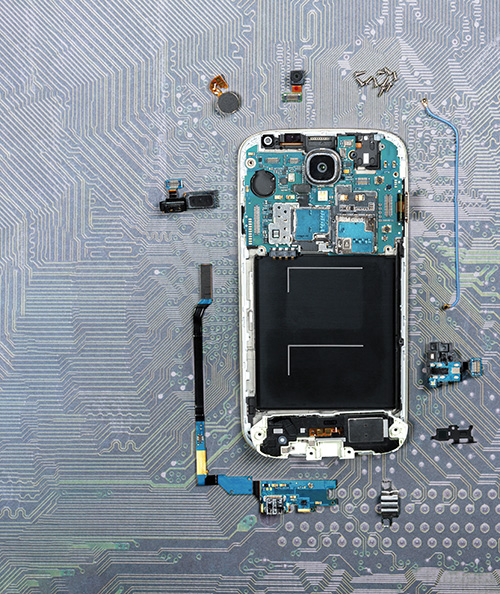
Every smartphone and almost any other electronic device contains valuable, reusable materials. And rising commodity prices are increasing their value.
One kilogram of gallium sells for 270 U.S. dollars. Tantalum is worth 260 U.S. dollars per kilo, and cobalt 24 U.S. dollars. Recycling is not only growing in importance because of the scarcity of these raw materials, but also because it is an intrinsic part of many new business models. However, it is difficult to recover such secondary raw materials from smartphones and tablets. For example, the tantalum contained in capacitors is present in such small quantities that it is almost impossible to extract. For lack of other options, many electronic components are simply melted down, with the result that the precious metals and rare earth metals they contain are no longer recoverable. Reinhard Noll and Cord Fricke-Begemann want to change this situation. The two researchers and their colleagues at the Fraunhofer Institute for Laser Technology ILT have developed an entirely new approach to recycling.
Prof. Noll coordinates the EU-funded next-generation urban mining project ADIR, or “automated disassembly, separation and recovery of valuable materials from electronic equipment,” in which nine partners from four countries have been studying this question since 2015. Dr. Cord Fricke-Begemann, who heads up the Materials Analysis group at Fraunhofer ILT, is the lead scientist for the institute’s share of the ADIR project. The Fraunhofer Institute for Factory Operation and Automation IFF in Magdeburg is responsible for the robotics components. Until now, the recycling process for electronic devices consisted of disassembling them and then attempting to extract reusable materials. ADIR takes a different approach, in which the electronic components are analyzed prior to disassembly to locate the desired materials.
The new approach astutely combines elements of existing, proven technologies: smart process control, agile robotics, high-resolution cameras and image processing, and no less than three different laser techniques. It is not without reason that Fraunhofer ILT is recognized as one of Europe’s leading addresses for laser technology research. The recycling plant consists of multiple workstations. At each one of them, the first step is to identify the product or component. Cellphones are sorted according to type and model, with the aid of a database. Then the cellphone casing is opened and removed. Special attention is paid to batteries, which are removed undamaged by a robot and recycled separately. The now exposed motherboard is photographed using a high-resolution camera and the images are processed by analysis software which compares them with data stored in the institute’s own database. In most cases, the software is capable of identifying the type of motherboard and pinpointing components containing rare earth metals and other raw materials of value.
This is where a technology in which the ILT possesses a great deal of expertise comes into play: the laser. It is used to perform three different tasks. The first is 3D sensing, which provides a topological profile of the circuit board, enabling further information to be gleaned about its structure and layout. The second is laser spectroscopy, which can penetrate below the surface of electronic components to locate materials worth recovering. Once these first two steps have been completed, a third laser is used to desolder or cut out individual components. By combining these methods, it is possible to extract tiny capacitors containing tantalum and transfer them to a fraction collection station. “We can enrich a tantalum fraction to a grade of over 30%, which is significantly higher than that of the tantalum concentrate used to produce the original product,” says project manager Fricke-Begemann.
Sometimes, modules may be glued to the motherboard or smartphone casing, for example the vibration alarm, which basically consists of a miniature motor and a counterweight. The latter is almost entirely composed of tungsten. To detach the motor from the casing, the Fraunhofer experts use an electromagnetic pulse wave.
The combination of people, software and cameras together with various laser-based measurement, desoldering and cutting tools and articulated robot arms create the perfect recycling team. In this way, it is possible to separate the parts of even the most complex and highly integrated electronic devices and recover secondary raw materials of the highest purity. Fricke-Begemann has spent five years working on this basic concept. The project is now nearing its end. It has passed the proof-of-concept stage and the process can now be tested at higher throughput rates to prove its viability in an industrial context. Before then, Fraunhofer ILT and its partners intend to make a few improvements. A few minor adjustments still have to be made before it can be handed over to industrial users.